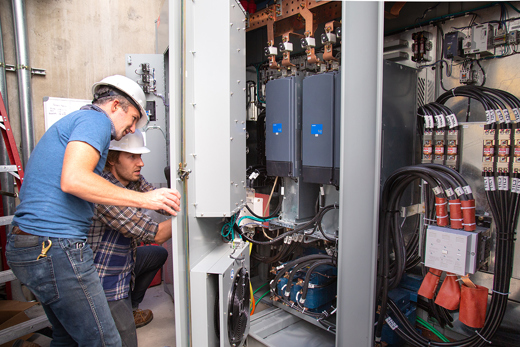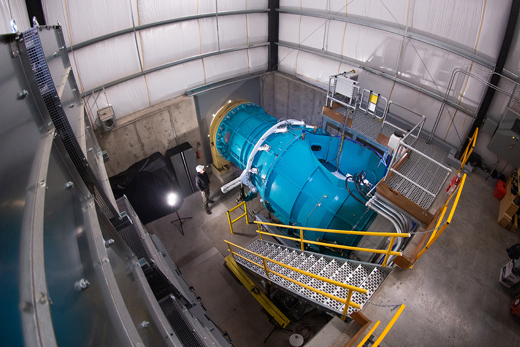Natel Energy is a pioneering water and energy company in Alameda, California, dedicated to advancing hydropower technology to make it more environmentally friendly, cost-effective and flexible enough to be a go-to source of power for operators in rivers of all sizes throughout the U.S. and around the world. With a name appropriately coined from the phrase “natural electric,” Natel is focused on enabling a distributed or decentralized hydropower model featuring a large number of smaller projects, as opposed to the current approach of huge centralized dams which tend to be damaging to wildlife and the adjacent ecosystem. Founded by Gia and Abe Schneider, siblings who gained a deep appreciation for the power of rivers and the beauty of their ecosystems during family camping and fishing trips as children, Natel is successfully advancing their vision of “Restoration Hydro,” combining low environmental impact with high economic value—a boon to organizations looking to decarbonize their operations further and transition to a low or zero-carbon grid.
“More than half of U.S. waterways are degraded, as are countless watersheds, rivers and wetland ecosystems around the world,” noted Gia Schneider, Natel CEO. “With the right technology and attractive business case, the restoration of these critical ecosystems is not only possible, but economically justifiable, with a sustainable, distributed hydropower backbone supporting a renewable, decarbonized electrical grid—without the need for large dams.”
Revolutionary fish-safe technology
Natel understood that a huge economic barrier to the practical deployment of renewable hydropower lies in the danger to fish represented by the spinning turbine blades of existing technologies. Ecosystem damage can be costly, as is initiating incumbent screening and other mitigation procedures, and permitting can be a challenging process.
Natel’s technical team, led by President and Chief Technology Officer Abe Schneider, rethought and redesigned the conventional axial flow propeller turbine, creating an innovative new design featuring blades with thick and forward-swept leading edges, which enables fish safety and high efficiency, while also allowing high turbine rotational speeds,resulting in compact turbine size.
“The design creates a pressure zone around the blades’ leading edges that acts like an ‘airbag’ for passing fish, minimizing impacts and allowing them to safely pass through the area,” he explained. The same phenomena also makes the unique turbine blades more resistant to damage or performance deterioration from entrained debris.
This new design would make the turbine nearly universally applicable; sized suitably for a range of applications, it would allow even small utilities to effectively supplement their power generation mix with clean, reliable hydropower. Further, to make the technology even more practical for prospective power generators, Natel sought to create a turnkey system featuring their new turbine, along with all machinery and equipment needed, that could be offered en masse in scalable sizes to their customers. A search for complementary technical partners began.

Technologically advanced, long term collaboration oriented
“To do what we wanted to do was not like ordering parts from the hardware store,” noted Abe. “There was a lot of custom engineering work that needed to be done. And we needed a partner willing and able to work with us.”
Abe explained that a key component of Natel’s strategy for a systems approach started with a regenerative variable frequency drive which enables the turbine generator to supply electricity to the grid continuously.
“Not all drives can do this—many variable frequency drives can’t withstand continuous reverse operation. We found that Danfoss is one of the few industrial scale VFD manufacturers that is capable of making a regenerative drive that is proven and reliable,” explained Abe. “ Their VACON® drive systems are designed, tested, certified and supported to run even up to 100% of the time in regenerative mode.” Additionally, he noted, what made Danfoss stand out even further from the other VFD suppliers they spoke with was their willingness to go beyond existing products and put together the system that would help bring the Natel vision of Restoration Hydro fully to life.
“We spoke with a number of quality companies but chose Danfoss due to a mix of their technical expertise and the fact that their team was so proactive and cooperative, willing to collaborate with us,” he said. “Danfoss shared our vision for the future—to create a flexible hydropower system that could be scaled as needed for different customers—they weren’t just looking for a one-off product sale.”
Showcase facility leads to high interest and a drive for implementations
Ultimately, Abe notes, Danfoss brought together technologies that could both handle the speed of the generator and also handle the regeneration of the electricity in one “comprehensive box”— a “packaging” that is a convenience for Natel and for future customers and will help drive commercialization and acceptance.
In September 2020 the team installed the first system on an irrigation canal near Madras, Oregon, generating power with water from the Deschutes River.
During the commissioning process, Natel’s engineers were able to rely on technical support from the Danfoss team. “We would do different things and see how the drive responded, looking at all the data. The Danfoss engineers knew their equipment very well , and were able to help fine-tune drive parameters over the phone and get it to perform just right—we were very impressed.”
“How is it performing? The team got the go-ahead approval from the utility to export power to them and within a day we were at the maximum rated capacity of the plant—300kW,” noted Abe. “And it’s been operating reliably since then.”

Scalability for future systems
“Danfoss is able to offer scalability for future systems of various power sizes,” commented Lise Houston, Regional Manager for Danfoss. VACON® NXP inverters and converters are available up to 5 MW in power that utilize the same software and control interface regardless of power size. Therefore, interfacing, communicating and application programming remains consistent from a small power system to a large power system.
Once utilities and generators began to see the possibilities, interest was high, and Natel is pursuing nearly 100 turbine deployment opportunities. Even in an industry where sales cycles can be a year or more—further slowed down in the age of COVID—customer response is promising, with several projects already contracted or in the negotiation stages—and numerous others in the pipeline.
“We expect several projects to be underway in 2021, with many more in 2022 and beyond—in fact, our goal is to ramp up to hundreds and then thousands of turbine systems per year,” said Gia. “And with Danfoss supporting us on the drive end, we are confident in meeting—or exceeding—all the goals that we have set.”
Originally published in Solutions magazine Winter edition 2020/2021
